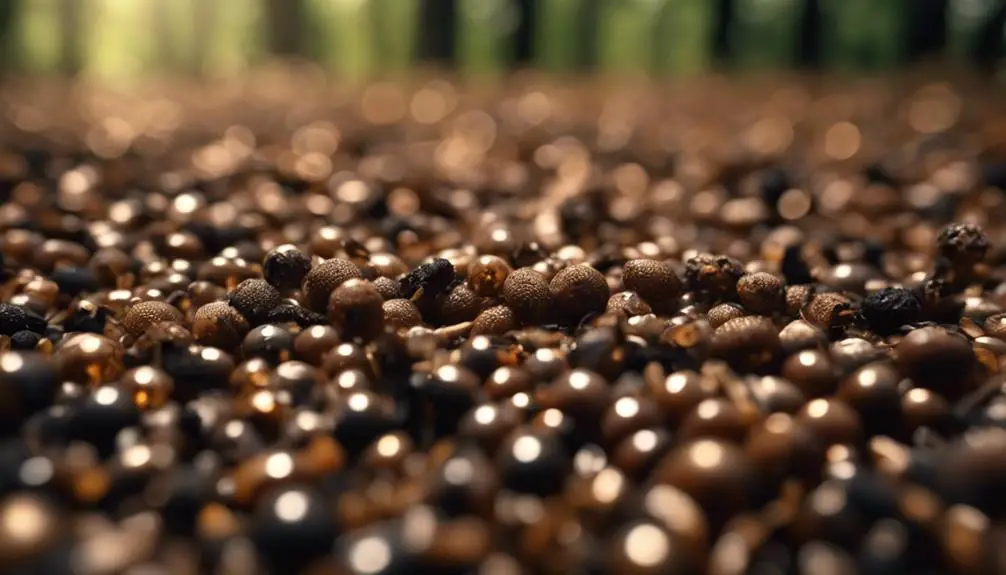If you’re curious, chipmunk poop is small, measuring 0.2 to 0.5 inches long and usually dark brown to black, occasionally with reddish or purple hues. It’s firm, dry, and compact. These droppings’ size and color can reveal aspects of their diet. Chipmunks use their poop for marking territory and finding food. Learning more about the appearance of chipmunk poop can help you identify their presence and habits.
Characteristics of Chipmunk Poop
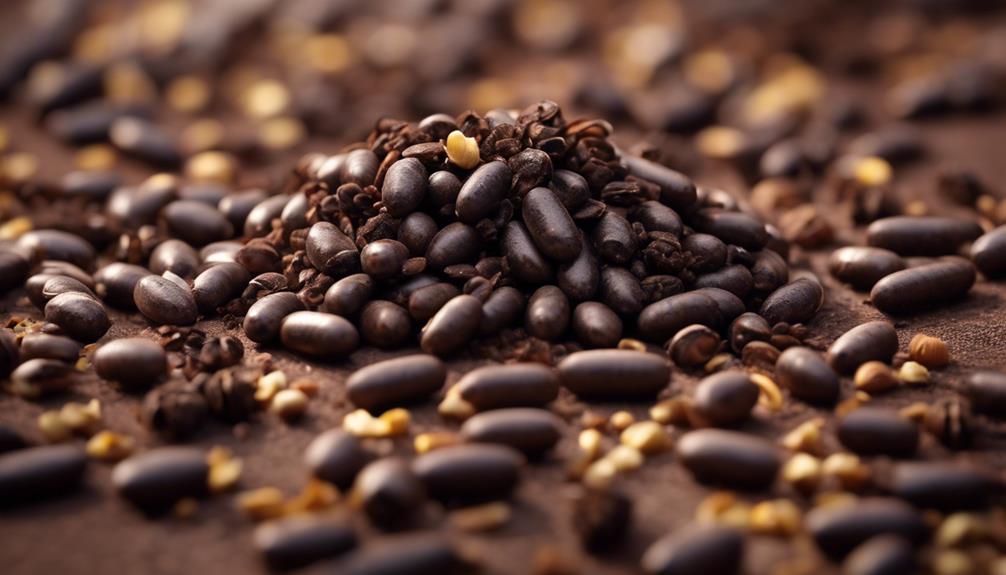
Chipmunk droppings are small, measuring between 0.2 to 0.5 inches in length, and are typically dark brown to black in color. These tiny feces can sometimes showcase reddish or purple tones, hinting at the fruits they consume. When you come across chipmunk poop, you’ll notice its firm, dry, and compacted nature, a sign of their efficient digestion process. Chipmunks use their droppings not only for waste elimination but also as markers for their territory and food caches.
Their quick metabolism means they defecate while foraging, aiding in remembering food locations. To stay safe, remember that chipmunk droppings can carry diseases like roundworms or tapeworms, so it’s important to handle them with care. Wear protective gear like gloves and a mask, use disinfectants, and clean thoroughly to prevent any health risks. Stay vigilant, differentiate their droppings from other animals’, and take steps to keep chipmunks away from your surroundings for a cleaner and safer environment.
Size of Chipmunk Droppings

When identifying chipmunk droppings, observe the small size ranging from 0.2 to 0.5 inches in length. These tiny droppings are a key characteristic that distinguishes them from those of other rodents.
Chipmunk poop is notably smaller compared to larger animals like squirrels or rats. The size of their droppings reflects the petite nature of these lively creatures.
Color Variations in Chipmunk Poop
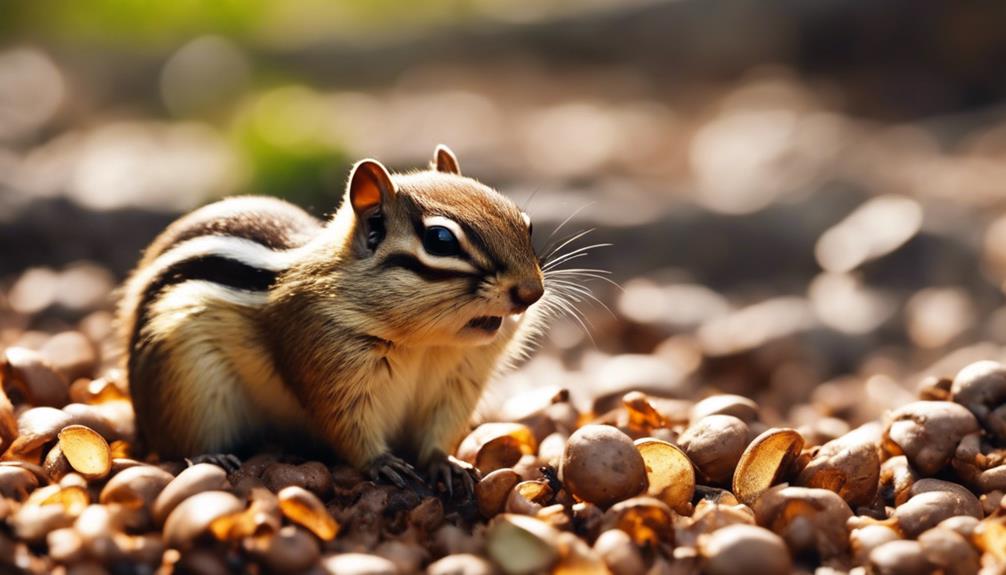
To further understand chipmunk droppings, consider the various color variations that can be observed in their feces. Chipmunk poop commonly ranges from dark brown to black, reflecting their omnivorous diet.
However, depending on what they eat, you may notice reddish or purple hues in their droppings. These colors can stem from berries, fruits, or insects in their diet, adding a touch of variation to their typically dark-colored feces.
Keep an eye out for these color variations as they can provide insights into the chipmunk’s recent food choices. By observing the different colors present in their droppings, you can gain a better understanding of their diet and habits.
Texture and Consistency of Droppings
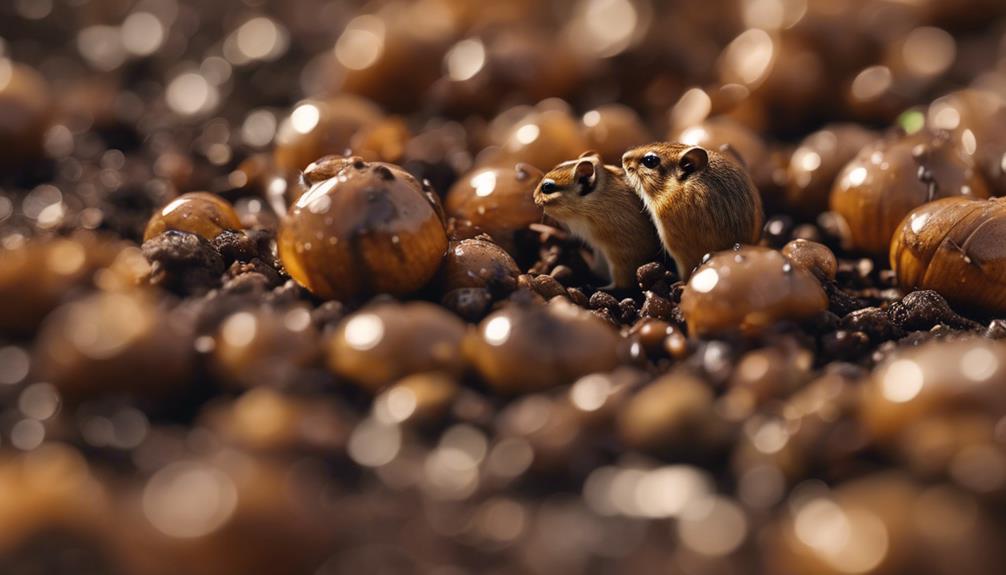
Exploring the texture and consistency of droppings reveals essential insights into the health and habits of these small mammals. Chipmunk droppings are typically firm, dry, and compacted. Their consistency reflects efficient digestion and a diet rich in nuts, seeds, fruits, and insects. When you come across chipmunk poop, you’ll notice that it crumbles easily when touched due to its dry nature. The compacted form indicates the chipmunk’s ability to extract nutrients effectively from its food sources.
The texture of chipmunk droppings is granular and uniform. As you inspect them closely, you may observe a lack of moisture, giving them a sandy feel. This dry texture helps in preserving the droppings for longer periods, aiding in territorial marking and food caching behaviors. Understanding the texture and consistency of chipmunk droppings can assist in identifying their presence in your surroundings and implementing appropriate pest control measures.
Chipmunk Dropping Behavior
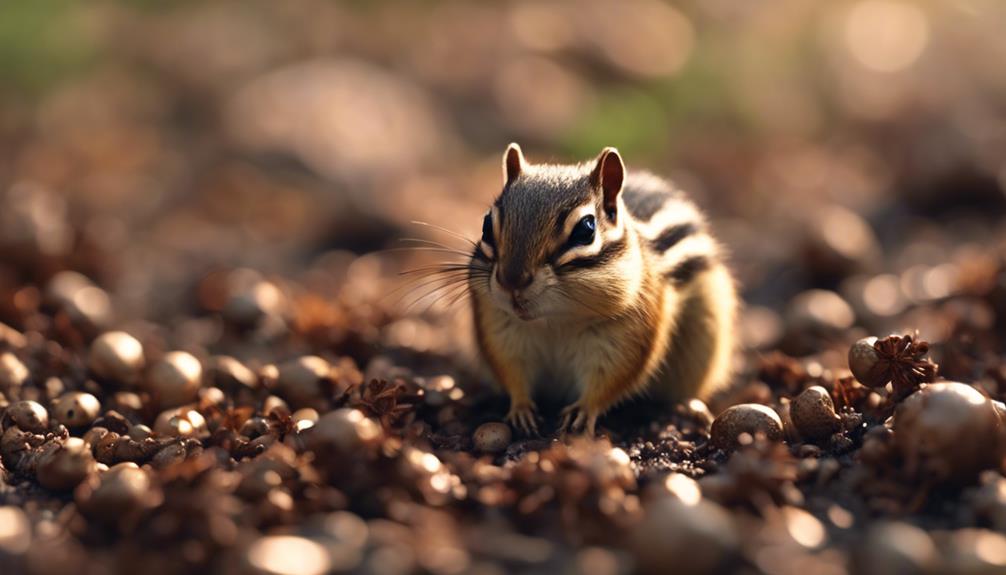
Inspect chipmunk dropping behavior closely to understand their communication and territorial habits. Chipmunks scatter their droppings strategically to mark their territory and indicate food storage locations.
As they forage, they defecate to aid in remembering where they’ve found food due to their fast metabolism. This behavior helps them efficiently manage their time and energy by reducing the need to revisit the same spots.
Chipmunks are known for their frequent defecation, which serves both practical and communicative purposes in their ecosystem.
Reasons for Dropping Scattering
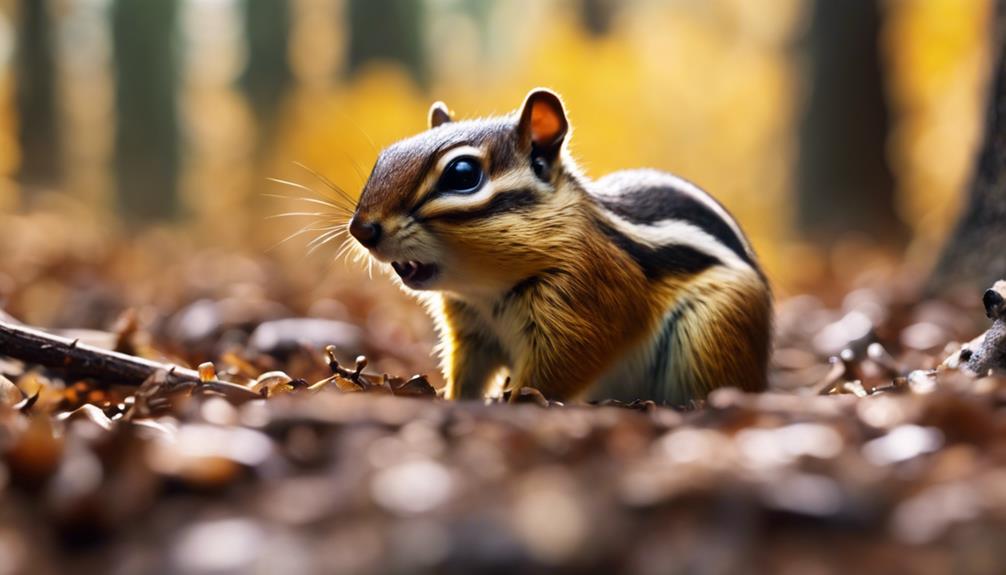
Scattering chipmunk droppings serves as an essential method for marking territory and communicating food storage locations efficiently. Chipmunks strategically place their droppings to establish boundaries and signal ownership of specific areas. By dispersing their excrement, chipmunks convey information to other chipmunks about available food sources and potential dangers. This behavior helps minimize conflicts over resources and reduces the likelihood of territorial disputes among chipmunks.
Furthermore, scattering droppings aids in navigation and memory retention for these small creatures. Chipmunks have a rapid metabolism and constantly forage for food, so leaving droppings in various locations helps them remember where they’ve found food previously. This practice allows chipmunks to optimize their foraging efforts by revisiting successful foraging spots efficiently.
Health Risks Associated With Droppings
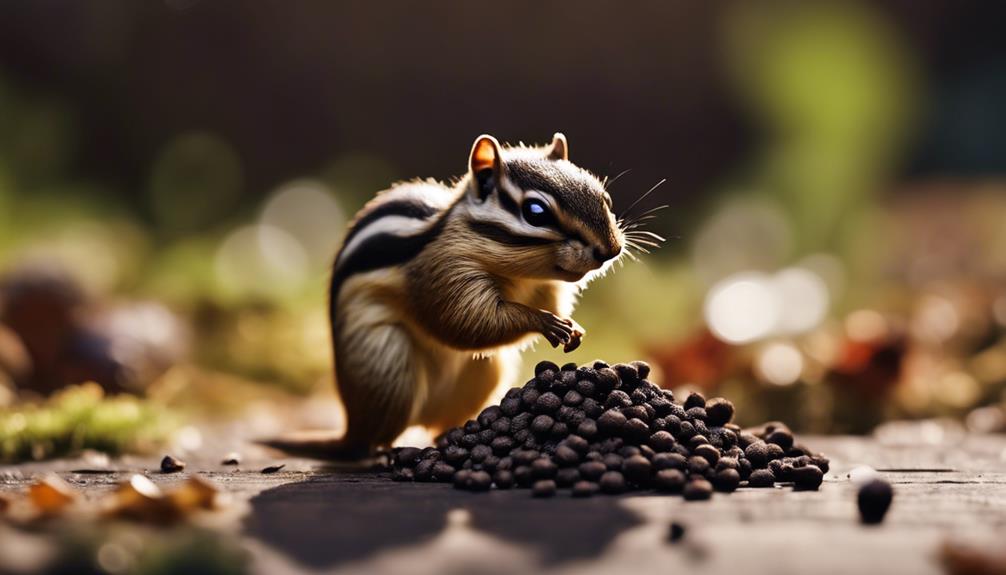
To understand the potential health risks associated with chipmunk droppings, consider the significance of proper hygiene practices and protective measures. Chipmunk feces can harbor zoonotic diseases such as roundworms and tapeworms, posing a risk to your health if not handled carefully.
When cleaning up droppings, wear disposable gloves and a mask to prevent direct contact and inhalation of any contaminants. Use paper towels and disinfectants to carefully remove the droppings, minimizing the spread of potential pathogens. After cleaning, thoroughly disinfect the area and wash your hands to prevent any possible transmission of diseases.
It’s essential to recognize the health hazards associated with chipmunk droppings and take proactive steps to protect yourself and your family. By following proper cleaning and safety protocols, you can minimize the risk of exposure to harmful bacteria and parasites present in these droppings.
Allergic Reactions to Chipmunk Poop
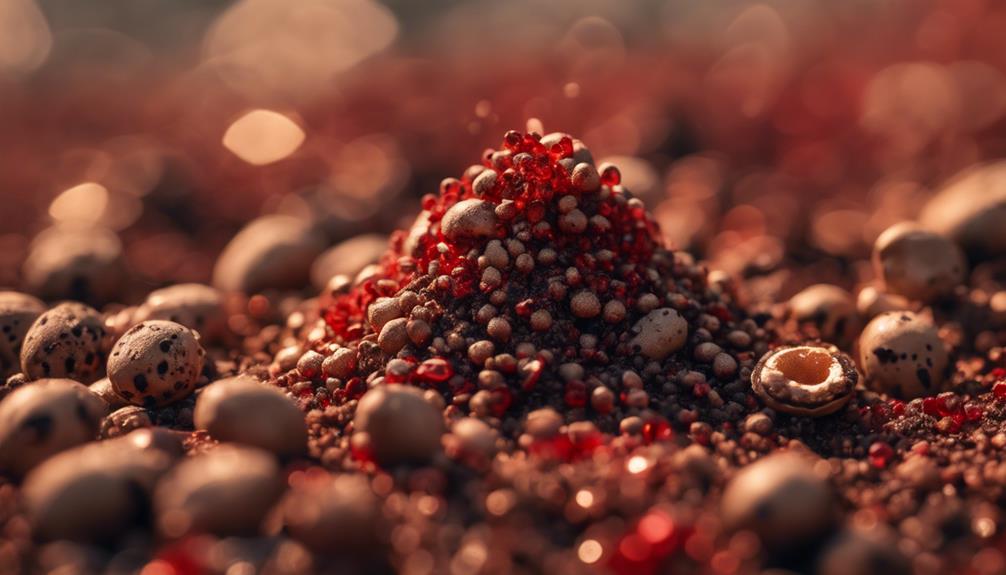
Considering the health risks associated with chipmunk droppings, it’s important to be aware of potential allergic reactions that can arise from exposure to these feces.
Allergic reactions to chipmunk poop may manifest as skin rashes, itching, redness, or even respiratory issues like sneezing, coughing, or difficulty breathing. If you have a known allergy to rodents or their droppings, coming into contact with chipmunk feces can trigger an allergic response.
Inhaling particles from dried chipmunk droppings or touching them without protection may lead to these reactions. Symptoms can vary in severity, so it’s essential to take precautions when handling or cleaning areas contaminated with chipmunk poop.
If you suspect an allergic reaction after exposure to chipmunk droppings, seek medical attention promptly. By understanding the potential allergic risks associated with chipmunk feces, you can better protect yourself and maintain a safe environment.
Cleaning Chipmunk Droppings Safely
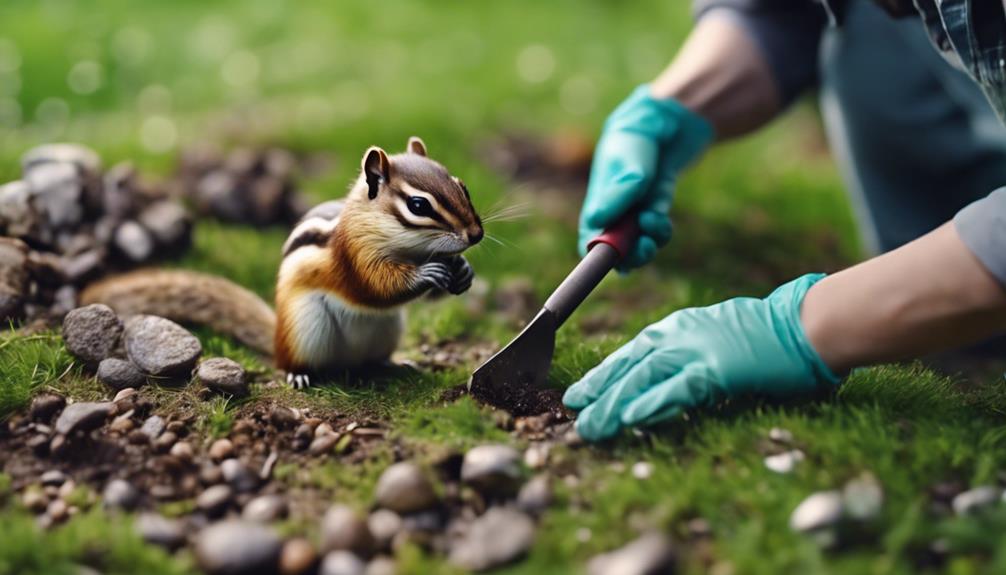
To guarantee safe cleaning of chipmunk droppings, make sure you have the necessary protective gear and cleaning supplies ready. Wear disposable gloves and a mask to protect yourself from potential pathogens. Use paper towels to carefully pick up the droppings, avoiding direct contact. Dispose of the droppings in a sealed plastic bag to prevent contamination.
Next, disinfect the affected area with a cleaner suitable for killing germs. Ensure you thoroughly clean the space where the droppings were found to eliminate any remaining bacteria or parasites. After completing the cleaning process, wash your hands thoroughly with soap and water.
Identifying Chipmunk Poop Vs. Others
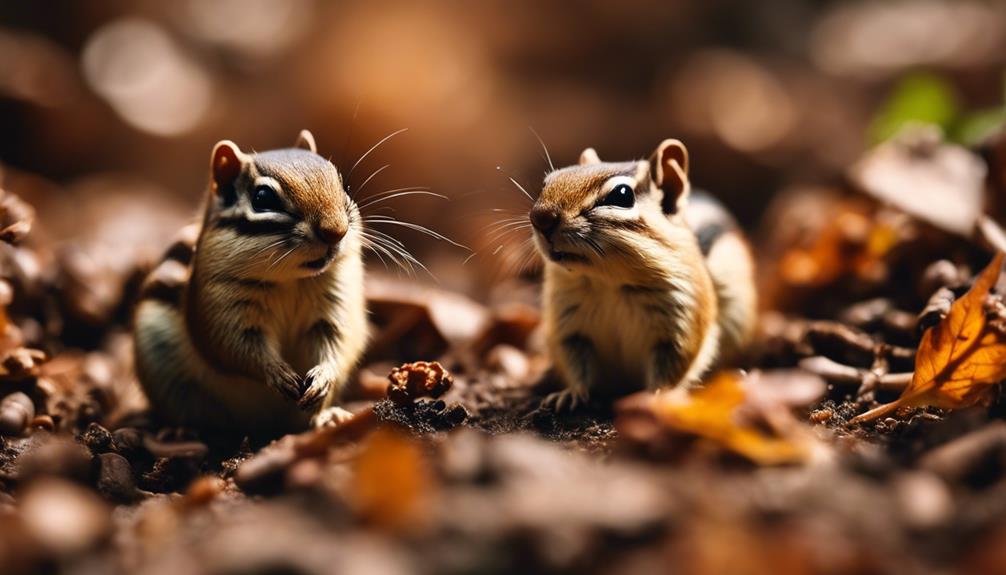
Guarantee accurate identification of chipmunk droppings by noting the distinct size, color, and texture that differentiate them from those of mice and squirrels. Chipmunk poop typically measures between 0.2 to 0.5 inches in length, smaller than that of mice and larger than squirrel droppings. The color ranges from dark brown to black, often displaying reddish or purple tinges due to their fruit-rich diet.
In comparison, mouse droppings are smaller and thinner, while squirrel droppings are larger and cylindrical. Chipmunk droppings are firm, dry, and compacted, reflecting their efficient digestive system. This contrasts with mouse droppings which are soft and moist, and squirrel droppings which are softer and less defined.
Preventing Chipmunk Droppings in Yard
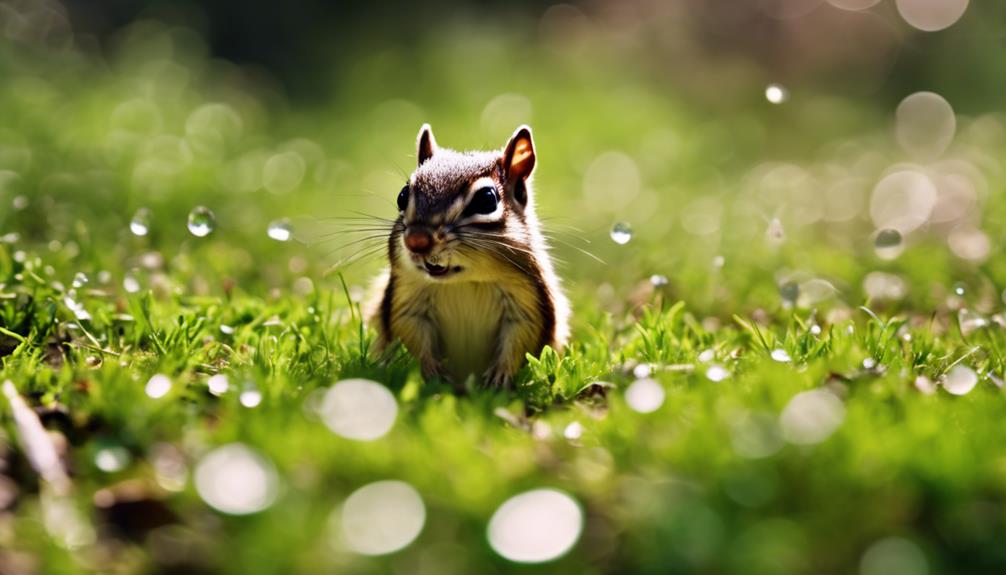
If you want to prevent chipmunk droppings in your yard, start by removing potential food sources and securing your bins. Chipmunks are attracted to easily accessible food like birdseed, fallen fruits, and pet food. Store birdseed in sealed containers, pick up fallen fruits regularly, and feed pets indoors to eliminate these temptations. Secure garbage bins tightly to prevent chipmunks from rummaging through them for food scraps. Additionally, consider installing motion-activated sprinklers or ultrasonic devices to deter chipmunks from entering your yard.
To further discourage chipmunks, trim vegetation and remove clutter where they can hide or build nests. Seal off any gaps or openings in fences, walls, or foundations to prevent chipmunks from entering your property. If you have a garden, consider using wire mesh or fencing to protect your plants from these furry foragers. By taking these preventive measures, you can help keep chipmunk droppings out of your yard and create a less appealing environment for these critters.

Erzsebet Frey (Eli Frey) is an ecologist and online entrepreneur with a Master of Science in Ecology from the University of Belgrade. Originally from Serbia, she has lived in Sri Lanka since 2017. Eli has worked internationally in countries like Oman, Brazil, Germany, and Sri Lanka. In 2018, she expanded into SEO and blogging, completing courses from UC Davis and Edinburgh. Eli has founded multiple websites focused on biology, ecology, environmental science, sustainable and simple living, and outdoor activities. She enjoys creating nature and simple living videos on YouTube and participates in speleology, diving, and hiking.
- WILDLIFE THEMED T-SHIRTS
Cute Hedgehog Embroidered: Love Wildlife, Protect Nature Wildlife conservation tees
$35.00

